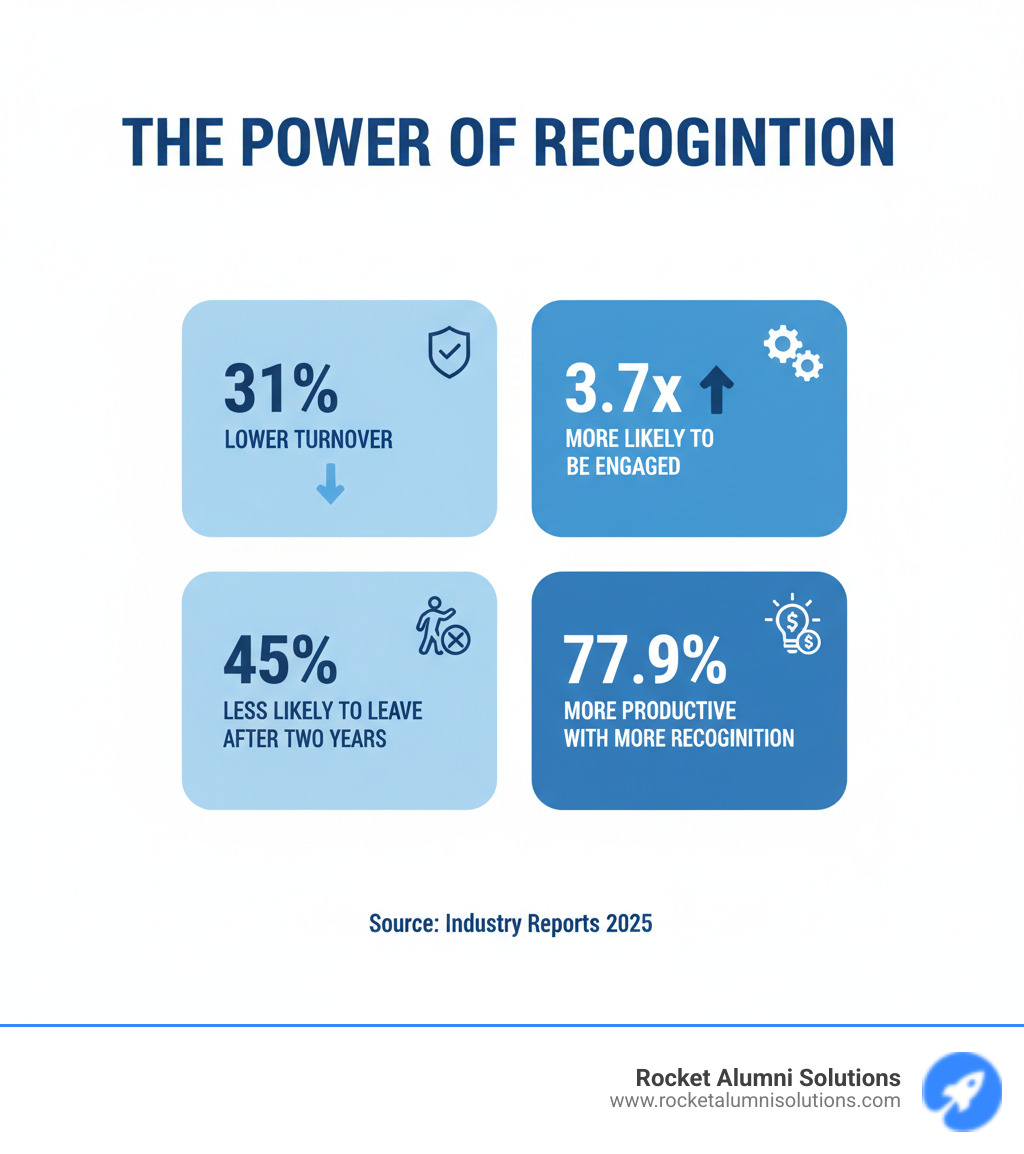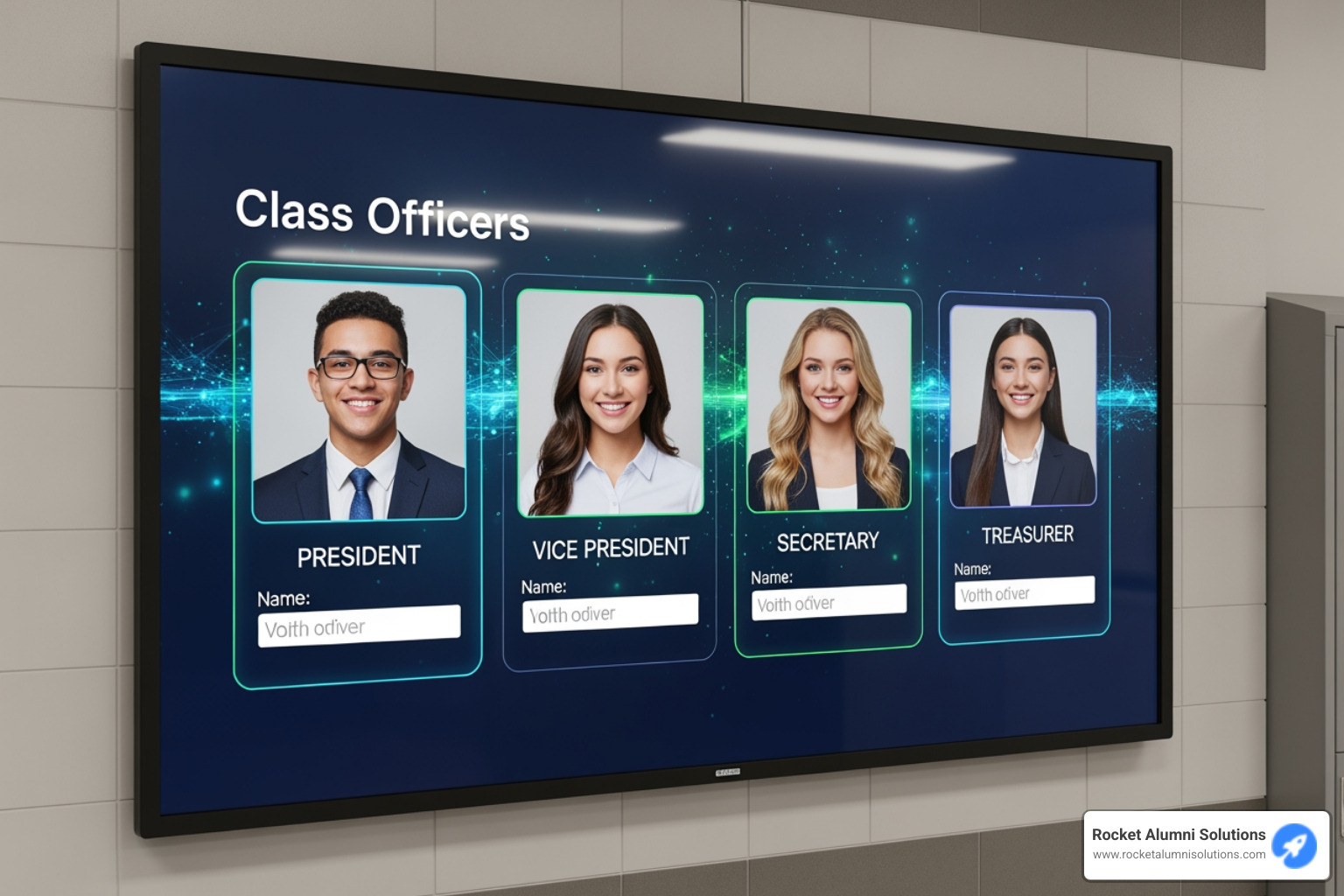Why Workplace Rewards and Recognition Matter More Than Ever
Workplace rewards and recognition ideas are proven strategies that boost morale, increase productivity, and reduce turnover. Here are some of the most effective options:
- Leadership-driven recognition: Public shout-outs, personalized letters, Employee of the Month awards
- Peer-to-peer recognition: Digital kudos channels, rotating team trophies, spontaneous praise
- Monetary rewards: Performance bonuses, gift cards, profit sharing, experiential rewards
- Non-monetary rewards: Extra PTO, flexible work hours, professional development, wellness days
A paycheck alone doesn't spark real motivation. In today's workplace, employees have an intrinsic need for esteem and belonging—research shows this is fundamental to human psychology. When that need goes unmet, even talented people start looking elsewhere.
The numbers back this up. Organizations with strong recognition programs see 31% lower turnover rates and are 12 times more likely to have better business outcomes. Employees in companies where recognition is woven into the culture are 3.7x more likely to be engaged at work. Yet 29% of employees haven't received recognition for good work in over a year.
Recognition isn't just a nice-to-have; it's a strategic tool that directly impacts your bottom line. When employees feel valued, they stay longer, work harder, and become advocates for your organization. The question isn't whether you can afford to invest in recognition—it's whether you can afford not to.
I'm Chase McKee, Founder & CEO of Rocket Alumni Solutions, and I've seen how thoughtful workplace rewards and recognition ideas transform organizations. When we personalized our recognition displays, our partners saw repeat engagement rise by over 25%—proving that making people feel seen drives real results.

Why Employee Recognition is a Game-Changer for Your Business
Recognition isn't just about making people feel good. It's a business strategy that delivers measurable results across your organization.
Consider employee engagement. When people feel appreciated, they don't just show up—they care about their work. Employees are 3.7x more likely to be engaged when they work in organizations with strong recognition cultures. Engaged employees are the ones innovating, collaborating, and going the extra mile.
Now let's talk about turnover. Replacing an employee costs anywhere from 30% to 200% of their annual salary. The good news? Organizations with recognition programs had 31% lower turnover rates and are 12 times more likely to see better business outcomes. Well-recognized employees are also 45% less likely to have left the company after two years. When people feel valued, they stick around.
Recognition also creates a productivity boost. When employees know their hard work gets noticed, they're motivated to keep delivering. In fact, many employees report they would be more productive if they received more frequent recognition. It's a simple equation—appreciation drives effort, which drives results.
The real magic happens in your company culture. Effective workplace rewards and recognition ideas don't just acknowledge individual achievements—they create an environment where everyone feels they belong. This fosters improved teamwork, builds increased trust between managers and their teams, and leads to improved well-being by meeting that fundamental human need for esteem.
The bottom line? Recognition transforms how people experience work—and that change shows up in your retention rates, engagement scores, and profits.
A Comprehensive List of Workplace Rewards and Recognition Ideas
Now that we understand the impact of recognition, let's dive into actionable workplace rewards and recognition ideas. The most effective approach combines different types of recognition to meet the diverse needs of your team.

Think of recognition as existing on a few key spectrums: formal versus informal, monetary versus non-monetary, and leadership-driven versus peer-to-peer. The key is mixing and matching these approaches to create a recognition ecosystem that resonates with everyone. Let's explore some specific examples.
When recognition comes from the top, it sends a powerful message that contributions are valued. Leadership-driven recognition carries significant weight, with 37% of employees citing it as most impactful. Formal programs provide structure and ensure achievements don't go unnoticed.
- Public shout-outs: Acknowledging contributions during company-wide meetings reinforces positive behaviors and inspires others.
- Personalized letters: A thoughtful letter from a manager or executive detailing specific contributions can have a profound impact.
- Mentorship opportunities: Offering high-potential employees mentorship with senior leaders recognizes talent while investing in their growth.
- Value-based awards: Recognizing employees who exemplify your company's core values strengthens your entire culture.
- Employee of the Month/Quarter: This classic program remains popular, especially when paired with perks like a prime parking spot.
- Service milestones: Celebrating work anniversaries and tenure acknowledges loyalty and long-term commitment.
Never underestimate the power of appreciation from colleagues. The people who work alongside you every day often have the clearest view of your contributions, making their acknowledgment incredibly meaningful.

- Peer nomination programs: Empower employees to recognize each other for outstanding contributions, fostering a shared positive culture.
- "Kudos" channels: Use platforms like Slack or Teams for public shout-outs, creating a vibrant feed of appreciation.
- Rotating team trophy: A quirky trophy passed around weekly to someone who made a standout contribution adds a fun, competitive element.
- Spontaneous praise: A simple "great job on that!" delivered in the moment costs nothing but carries genuine weight.
- Handwritten thank-you notes: In a digital world, taking time to write a personal note of gratitude is a memorable gesture.
- Recognition wall or board: A physical or virtual space where employees can post notes and messages appreciating their colleagues.
Effective Monetary Workplace Rewards and Recognition Ideas
Sometimes, monetary rewards are the most effective way to acknowledge significant contributions. The key is to define clear criteria and communicate them transparently to ensure fairness.
- Performance bonuses: Directly link financial rewards to achieving specific targets, KPIs, or project milestones.
- Spot bonuses: Small cash rewards given on the spot for going above and beyond are powerful and memorable.
- Profit sharing: These programs make employees feel invested in the company's success and encourage collective effort.
- Gift cards: Offering gift cards to popular retailers or restaurants gives employees the flexibility to choose their own reward.
- Experiential rewards: Tickets to sporting events, concerts, or local attractions create memorable moments that often resonate more than cash.
- Charitable donations: Making a donation in an employee's name appeals to those motivated by social impact.
Effective Non-Monetary Workplace Rewards and Recognition Ideas
Not all valuable rewards come with a price tag. Non-monetary recognition shows you value an employee's time, well-being, and professional growth.
- Extra paid time off (PTO): An extra day or half-day off is almost universally appreciated as a reward for hard work.
- Flexible work hours: Greater flexibility in start/end times or compressed workweeks shows trust and helps with work-life balance.
- Professional development: Sponsoring courses, workshops, or conferences signals that you're invested in an employee's future.
- Wellness days or perks: Dedicated wellness time, on-site massages, or subsidized gym memberships show genuine care for employee well-being.
- Prime parking spots: A designated spot for an "Employee of the Week" is a simple but surprisingly effective perk.
- Choice of projects: Giving high performers their choice of assignments shows you respect their interests and judgment.
- Upgraded equipment: A better chair, a standing desk, or a larger monitor shows you care about an employee's daily comfort and productivity.
How to Build a Sustainable and Effective Recognition Program
Building a recognition program isn't a one-time event. To make a difference, your workplace rewards and recognition ideas must become part of your organization's DNA.

Every successful program starts with a clear purpose. Are you trying to reduce turnover, boost engagement, or reinforce company values? Defining your goals provides a roadmap for measuring success.
Next, align recognition with company values. When you reward behaviors that reflect your core principles, you reinforce what matters most to your organization. Also, be sure to involve your employees in the design process. Use surveys or focus groups to ask what they find most meaningful. Their input ensures the program feels authentic.
Setting a realistic budget is also crucial. Recognition doesn't have to be expensive; many meaningful gestures are free. A common guideline is to allocate about 1% of total payroll, but you can start smaller and scale up.
As you build your program, watch out for common pitfalls like a lack of personalization, creating unhealthy competition, or neglecting remote and frontline workers. You also need to measure success with concrete KPIs like engagement scores and retention rates. Given that nearly a quarter of employees feel underappreciated, getting this right is essential.
Best Practices for a Successful Rollout
Even the best workplace rewards and recognition ideas will fall flat without a thoughtful launch strategy.
- Communicate the purpose: Explain why the program matters. When people understand the goal, they are more likely to participate.
- Pick a manageable system: Start with something easy to use, like a dedicated Slack channel for kudos or a simple recognition tool. If it's complicated, people won't use it.
- Measure and iterate: Regularly check participation rates and gather feedback. Don't be afraid to make changes based on what you learn.
- Keep it fun and varied: Rotate your recognition ideas and rewards to keep things fresh and appeal to different preferences.
- Ensure authenticity: Recognition must be genuine and specific. Gallup research shows that employees who receive authentic recognition are seven times as likely to feel respected at work.
- Recognize big and small wins: Don't wait for monumental achievements. Acknowledging milestones, helpful gestures, and consistent dedication creates a positive feedback loop.
Modernizing Your Program with Technology and Inclusivity
In today's hybrid and remote workplace, technology is essential for making workplace rewards and recognition ideas inclusive and effective.
Recognition tools and systems can streamline the entire process, from automated milestone tracking to peer-to-peer kudos. They help replace scattered, manual efforts with scalable systems that ensure every employee, regardless of location, feels seen. This is crucial, as executives often report feeling challenged to keep remote workers engaged.
Technology makes appreciation visible, timely, and accessible from anywhere. Consider virtual parties with treats sent in advance, or digital recognition walls that create a continuous stream of positivity. Gamification—using points, badges, and leaderboards—can make recognition more engaging for distributed teams.
Personalization is where technology shines. Modern systems can tailor recognition to individual preferences, offering diverse reward catalogs so each person can choose something meaningful. At Rocket Alumni Solutions, we've seen how digital recognition transforms engagement. When we help communities create stunning digital walls of fame with digital awards recognition, we're building lasting cultures of appreciation. The same principle applies to any workplace: make recognition visible, accessible, and meaningful, and watch your culture transform.
Frequently Asked Questions about Workplace Rewards
Here are answers to common questions about implementing workplace rewards and recognition ideas.
How often should employees be recognized?
Frequently. While formal awards for major milestones are great, it's the consistent, informal recognition that builds a strong culture. Think of it as a steady rhythm of appreciation. Team members should hear "thank you" for their day-to-day contributions, not just for huge project completions.
When you build recognition into both big moments and small, everyday wins, you create an environment where people feel valued. Daily informal praise paired with meaningful formal awards creates the perfect balance to keep everyone engaged.
Should recognition be public or private?
Both. The best approach depends on the individual's personality and the situation. Some people love public acknowledgment in a meeting or on a digital recognition wall. It reinforces company values and can inspire others.
However, not everyone craves the spotlight. For more introverted team members, a private, personalized thank-you—whether a one-on-one conversation or a thoughtful email—can be far more meaningful. The key is to know your people. Offering both public and private options ensures everyone feels appreciated in a way that resonates with them.
How much should a company budget for employee recognition?
There's no magic number, as the ideal budget for workplace rewards and recognition ideas depends on company size, industry, and goals. A commonly cited guideline is to allocate around 1% of your total payroll toward recognition initiatives. This provides a solid starting framework.
You don't need a massive budget to make an impact. Start small and scale up. Focus on a smart mix of low-cost, high-impact rewards (like extra PTO or public shout-outs) alongside monetary incentives for major achievements. Many of the most powerful ideas, like handwritten notes or peer kudos, cost virtually nothing.
The cost of not recognizing employees—through high turnover and disengagement—is almost always far greater than the investment in a thoughtful recognition program. It's not just an expense; it's an investment in your people.
Conclusion
Workplace rewards and recognition ideas are essential tools that directly shape your company's future. When employees feel genuinely valued, everything else—from engagement and productivity to retention—falls into place.
Recognition is a strategic driver of measurable results. It doesn't have to be complicated or expensive; the most powerful gestures are often the simplest. The most effective programs are authentic, timely, specific, and inclusive. They balance formal awards with informal appreciation and ensure everyone, no matter their role or location, feels seen.
Technology is a game-changer for making recognition accessible, but the heart of it remains deeply human. It's about fostering a culture of appreciation where celebrating achievements becomes second nature.
At Rocket Alumni Solutions, we've built our business around making achievements visible and engaging. We help educational and athletic communities celebrate their legacies through customizable digital displays. We believe recognition should be dynamic, accessible, and celebrated widely, whether you're honoring students, athletes, or employees.
Starting your own program doesn't have to be overwhelming. Begin with small, genuine gestures, ask your team what matters to them, and build from there. The investment you make in recognition will come back many times over in loyalty, productivity, and a workplace where people thrive.
Your team's achievements deserve to be celebrated. If you're ready to transform how your organization recognizes excellence, we'd love to help. Create a stunning digital wall of fame with digital awards recognition that makes every accomplishment shine.



















































































































































































































































































































